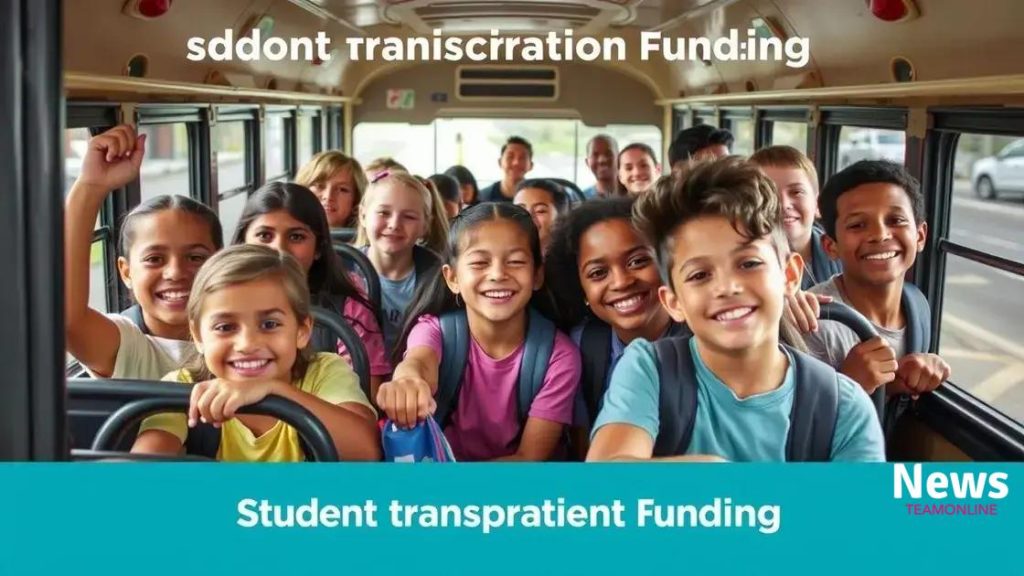Funding proposal for student transportation: how to secure support

Funding proposals for student transportation are crucial for securing resources that ensure safe and reliable transit for students, directly impacting their access to education and overall success.
Funding proposal for student transportation is a crucial step in ensuring students have safe and reliable transport. Have you considered how vital this aspect is for education and accessibility? Let’s dive into what makes a compelling proposal.
Understanding the need for student transportation funding
Understanding the need for student transportation funding is essential for creating equal opportunities for all students. Many children rely on school transportation to access education, regardless of their background or location. Without adequate funding, these services could diminish, affecting students’ overall learning experience.
Why is Student Transportation Important?
Student transportation is a vital component of the educational system. It ensures that children arrive at school safely and on time. Many families depend heavily on reliable transport to ensure their children can attend school without interruptions. Here are some reasons why this funding is crucial:
- Accessibility: Proper funding helps maintain services in rural and urban areas.
- Safety: Investing in transportation ensures safety regulations are met.
- Attendance: Reliable transport can increase student attendance rates.
- Equity: Equal access to education for all students across different regions.
Furthermore, funding can strengthen community ties by promoting a safe and reliable transportation network. Schools can collaborate with local agencies to improve routes and safety measures. This connection between schools and communities is vital for fostering a supportive environment for education.
Challenges of Funding
Despite its importance, student transportation funding faces significant challenges. Budget constraints often lead to cuts in transportation services. Additionally, fluctuating enrollment numbers can complicate funding decisions, making it harder for schools to allocate necessary resources effectively.
Moreover, engaging stakeholders can be complex. Schools need to demonstrate the importance of transportation funding to local governments and communities clearly. Innovative approaches to funding, such as co-sponsored initiatives, may help alleviate these issues.
In conclusion, understanding the need for student transportation funding is vital. Ensuring all students have access to reliable transportation not only supports their education but also fosters community involvement and support.
Key elements of a successful funding proposal
Crafting a successful funding proposal requires careful attention to detail and a clear understanding of key elements. These components form the backbone of your request and help convey your message effectively. A well-structured proposal can make the difference between receiving support and being overlooked.
Essential Components of Your Proposal
When you write your funding proposal, include the following essential elements:
- Executive Summary: Start with a concise overview that outlines the purpose, goals, and significance of your proposal. This should grab the reader’s attention.
- Needs Statement: Clearly define the problem or need that your project addresses. Use statistics and testimonials to support your claims.
- Project Description: Outline the specifics of the project or program you are proposing. Cover objectives, strategies, and the timeline for implementation.
- Budge: Present a detailed budget that outlines all anticipated costs associated with the project. This transparency helps build trust.
Each of these elements plays a crucial role in demonstrating the importance of your project. As you write, remember that clarity is vital. You want to ensure that funders understand exactly what you need and why.
Engaging with Stakeholders
In addition to the aforementioned sections, engaging stakeholders is vital for your proposal’s success. They can provide valuable insights and support your project through their networks. When writing your proposal, consider how to involve various parties:
- Collaboration: Highlight any partnerships that will strengthen your project.
- Community Input: Show how community feedback shaped your proposal.
- Endorsements: Include letters of support from key community members or organizations.
These strategies not only enhance your proposal but also demonstrate community backing, which can be a significant factor for funders. A strong, well-supported proposal will resonate more effectively with readers.
Ultimately, a successful funding proposal clearly outlines the purpose and need for funding. Each element works together to convey your message and motivate potential funders to support your project.
Strategies to engage stakeholders effectively

Engaging stakeholders effectively is crucial for ensuring the success of any funding proposal. The more involvement and support you can obtain, the stronger your proposal will be. Stakeholders can include parents, community members, local businesses, and government representatives. Understanding how to engage them can make a significant difference.
Identify Key Stakeholders
The first step in engaging stakeholders is to identify who they are. Knowing your audience allows you to tailor your approach. Potential stakeholders include:
- Parents: They have a vested interest in the transportation of their children.
- Local Government Officials: They can provide insights into funding opportunities.
- Community Organizations: These groups often have resources or influence within the community.
- Businesses: Local companies may support initiatives that benefit the community.
Once you have identified the relevant stakeholders, it’s time to consider how to effectively engage them. This involves communication and collaboration.
Effective Communication Strategies
Open and transparent communication is key to stakeholder engagement. Keeping everyone informed fosters trust and collaboration. Here are some strategies to enhance communication:
- Regular Updates: Share progress reports and any changes to the proposal.
- Feedback Opportunities: Create channels for stakeholders to provide input and suggestions.
- Workshops and Meetings: Organize events where stakeholders can meet, learn, and discuss the proposal.
Engagement is not a one-time effort. It requires regular interaction and input throughout the proposal development process. Keeping stakeholders involved creates a sense of ownership and investment in the project.
Building Relationships
Building strong relationships with stakeholders can lead to long-term support. Trust is essential in securing backing for your proposal. Take time to understand their needs and concerns, and be open to incorporating their feedback. Personalized interactions, such as one-on-one meetings or small group discussions, can be very effective.
Utilizing a mix of community surveys, social media engagement, and meetings will help keep the lines of communication open. Remember that successful engagement is about long-lasting relationships, not just a means to an end.
Common challenges and how to overcome them
When pursuing funding for student transportation, many common challenges can arise. Recognizing these obstacles is the first step in overcoming them. Understanding how to navigate these issues can significantly improve your chances of securing the necessary funding.
Identifying Challenges
One significant challenge is the competition for limited funding resources. Many programs and projects vie for the same funding sources, making it essential to present a compelling case. Additionally, fluctuating budgets and changing priorities can impact funding availability. This uncertainty can create difficulties in planning and budgeting for transportation services.
Strategies for Overcoming Challenges
To address these challenges effectively, consider the following strategies:
- Develop a Solid Proposal: Your proposal should clearly outline the need for funding, benefits to the community, and a well-structured budget. Ensure it resonates with potential funders.
- Build Community Support: Gaining support from parents, local organizations, and businesses can strengthen your case. Engage stakeholders early on and include their input in your proposal.
- Stay Flexible: Be prepared to adapt your proposal based on feedback and changing circumstances. This flexibility can help you respond to funders’ priorities and concerns.
Moreover, fostering relationships with funding agencies can be beneficial. Regular communication helps keep you updated on available opportunities and requirements. It can also demonstrate your commitment and transparency, which funders appreciate.
Leveraging Data and Research
Utilizing data to support your case is another effective strategy. Gather statistics on student transportation needs and any relevant studies that highlight the positive impacts of reliable transportation. This information can provide compelling evidence to funders that your initiative is worthwhile.
Ultimately, addressing challenges requires a proactive and strategic approach. By being prepared and informed, you can increase your chances of successfully overcoming obstacles and securing funding for student transportation.
Case studies on successful funding initiatives
Case studies on successful funding initiatives provide valuable insights into how effective strategies can lead to positive outcomes. They serve as real-world examples of how communities can successfully obtain funding for student transportation projects.
Example 1: Community Partnership Initiative
One noteworthy case is the Community Partnership Initiative in a small town. Local schools collaborated with businesses and non-profit organizations to raise funds for a new fleet of buses. They organized events, such as charity runs and bake sales, which not only generated funds but also increased community awareness.
- Outcome: The project successfully raised over $50,000, allowing the school district to purchase new buses.
- Benefit: Increased student attendance due to reliable transportation options.
This example highlights the importance of community involvement and collaboration. When different sectors come together, they can create significant changes that benefit all.
Example 2: Grant Application Success
Another successful initiative involved a school district applying for a federal grant aimed at improving student mobility. The district conducted thorough research to demonstrate the need for improved transportation and included testimonials from parents and students.
- Key Strategies: They utilized data to back their proposal and highlighted the positive impact on student learning.
- Results: The district received a grant of $100,000 for upgrading their transportation infrastructure.
This case shows the power of data and well-prepared proposals. It emphasizes how effectively communicating the need for funding can resonate with grant agencies and decision-makers.
Example 3: Innovative Fundraising Campaigns
In another instance, a school implemented an innovative crowdfunding campaign to finance transportation costs. They created a clear, engaging online platform where parents and community members could donate directly to the cause.
- Engagement: Use of social media to spread awareness and attract donors.
- Impact: The campaign exceeded its goal by 150%, raising $30,000 within two months.
This example illustrates how creativity and modern technology can vastly improve fundraising efforts. Engaging the community through social media played a crucial role in their success.
FAQ – Frequently Asked Questions about Funding Proposals for Student Transportation
Why is funding for student transportation so important?
Funding is vital to ensure students have safe and reliable transportation, which helps improve attendance and overall educational outcomes.
What are effective strategies for engaging stakeholders?
Effective strategies include building strong community relationships, maintaining open communication, and involving stakeholders early in the proposal process.
How can data support a funding proposal?
Using data in proposals helps demonstrate the need for funding and can provide evidence of the potential impact on student success and community benefit.
What are some examples of successful funding initiatives?
Successful initiatives include community partnership campaigns, effective grant applications, and innovative crowdfunding efforts that engaged and rallied community support.





